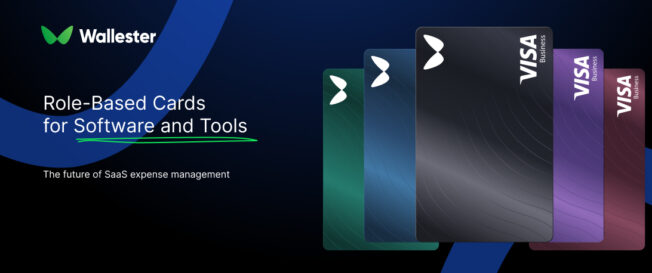Modern companies rely on dozens of software tools and online subscriptions to stay productive – from project management apps to data platforms. Yet the convenience of SaaS often turns into chaos when payments are spread across teams, personal cards, or forgotten renewals. On average, organisations now use 275 SaaS products, with this rate continuing to rise.
A smarter approach is to link spending directly to roles within the organisation. Role-based virtual cards bring order to digital purchasing by giving each department or function a dedicated payment method. This simple shift helps finance teams track costs, set limits, and maintain transparency without slowing anyone down.
What are role-based cards?
A role-based card is a virtual or physical payment card assigned to a department, project, or function rather than a single employee. Instead of asking staff to share one corporate card or pay with personal ones, each business role gets its own card with a clear purpose, such as marketing subscriptions, development tools, or HR software.
Every transaction is recorded under the right cost centre, giving finance teams instant visibility of how much each department spends on software. It’s a clean, structured way to handle recurring payments in companies where multiple teams rely on SaaS tools every day.
Why SaaS and tool management need a role-based approach
SaaS spending often grows quietly until it becomes a problem. Many firms discover they are paying for overlapping tools, unused licences, or forgotten subscriptions simply because no one owns them.
A role-based model prevents this by assigning responsibility and budget to each function.
Common challenges that lead to wasted spend include:
- Subscriptions are distributed across multiple teams, with no centralised record.
- Employees using personal or shared cards to buy tools.
- Lack of ownership – no one knows who approved a subscription or if it’s still needed.
- Difficult forecasting – finance teams can’t predict renewal costs accurately.
When each role has its own card, ownership becomes clear. Marketing handles its analytics subscriptions, product teams manage design or development tools, and finance has complete visibility across the organisation.
Further Reading: The Ultimate Guide to Managing SaaS and Subscription Spend
How role-based cards improve financial control
Role-based cards act as both a budgeting and compliance tool. By linking spend to function, they allow companies to manage software costs proactively rather than reactively.
Key advantages include:
- Ownership clarity – every payment has a responsible team, so renewals and approvals are handled by those who actually use the service.
- Simplified approvals – managers can set spending limits, approve renewals, or freeze cards in seconds.
- Audit-ready records – all transactions are tied to departments, simplifying monthly reporting and financial audits.
- Reduced shadow IT – unapproved tools can’t slip through unnoticed, as every purchase goes through an authorised card.
- Accurate forecasting – visibility into active subscriptions makes budgeting far more predictable.
This structure brings discipline to spending without creating bureaucracy. Teams can still act independently while finance teams see the bigger picture.
Best practices for implementing role-based spend controls
Transitioning from scattered software payments to a structured card system requires planning, but the payoff is immediate clarity.
Here’s how companies usually roll it out:
- Map responsibilities. List all teams and assign ownership for the tools they use.
- Create role-specific cards. Each department or function receives its own card for SaaS expenses.
- Link cards to budgets. Set monthly or quarterly limits aligned with existing cost centres.
- Connect to accounting systems. Integrate card data with accounting or ERP platforms for live tracking.
- Review regularly. Reassess subscriptions and budgets every few months to catch unused tools or overlapping services.
The goal isn’t to control teams, but to give them freedom within defined financial boundaries. When everyone knows their limits, overspending naturally declines.

Real-world scenarios and use cases
Role-based cards fit almost any business model, but they’re particularly useful in SaaS-heavy environments.
- Marketing teams often manage multiple ad platforms, analytics tools, and content services. With a dedicated card, they can handle all these costs transparently and keep track of ROI.
- Engineering and product teams rely on design apps, code repositories, and cloud infrastructure. Linking payments to their role means finance can instantly see total technical spend.
- Operations or HR departments pay for recruitment, payroll, and collaboration software. Separate cards make it easy to reconcile costs by function and track contract renewals.
Each use case improves accountability, as the same card covers the entire lifecycle of a subscription – from activation to renewal or cancellation.
Further Reading: SaaS Subscription Sprawl: How Virtual Cards Keep Costs Visible
Integrating role-based cards with accounting and ERP systems
For finance leaders, integration is the defining advantage. Modern card platforms can synchronise data directly with ERP or accounting software. When a department pays for software using its role-based card, the transaction automatically flows into the ERP system, tagged with cost-centre information. That data becomes part of the company’s financial dashboard, supporting:
- Accurate real-time reporting
- Simplified tax and compliance management
- Automated journal entries and reconciliation
The technology behind role-based spend management
The power of this model lies in automation. Role-based card systems combine several modern tools that make expense management almost effortless:
- Real-time spending controls. Transactions are approved or blocked instantly according to pre-set limits.
- Tagging and categorisation. Each transaction is labelled by vendor, category, or department, building a clear picture of SaaS usage.
- Automated renewals and alerts. The system notifies users before renewals occur, helping avoid accidental overspend.
- Analytics dashboards. Finance leaders can spot patterns — rising software costs, duplicate licences, or unused tools – and take action early.
- API integrations. These connect directly to ERP, HR, and project management systems, allowing a complete financial view across the business.
By using technology to automate the routine parts of expense management, teams can focus on strategy and planning rather than administration.
Role-based cards and employee autonomy
One of the biggest misconceptions about structured spend control is that it limits flexibility. In reality, role-based systems increase autonomy. When employees or teams have their own cards, they can purchase what they need instantly – within approved boundaries.
Managers no longer act as bottlenecks for every small transaction, and finance teams don’t have to micromanage day-to-day spending. Instead, employees make informed decisions while the system provides automatic oversight. The result is a healthier spending culture: transparent, responsible, and free from unnecessary friction.
Further Reading: Controlling Hidden SaaS Costs: Identifying and Reducing Shadow IT
Why role-based virtual cards are the future of SaaS expense management
The number of SaaS tools per company remains high. Zylo’s 2025 SaaS Management Index reports an average portfolio of 275 applications (up 2.2% year over year). Okta’s 2025 Businesses at Work shows the global average apps per customer has topped 100 for the first time.
Role-based virtual cards offer the framework modern companies need – one that balances agility with accountability. They give teams control over their budgets while providing finance with the data required for forecasting and compliance. For SaaS-driven businesses, this approach turns expense management into a strategic asset.
How Wallester supports role-based spend management
Wallester Business provides the tools companies need to turn the role-based model into a practical reality. It’s built for teams that rely on dozens of digital tools yet want to stay in full control of every subscription and payment. Rather than sorting through shared cards or chasing numbers in spreadsheets, finance managers can assign specific cards to every team and keep a clear view of all expenses in one place.
With Wallester Business, every payment is linked to a purpose. A card issued for marketing can be used across ad platforms and analytics tools; another, created for product development, covers design and software licences. This separation helps identify exactly where money goes and how much each department contributes to total software costs.

Main capabilities include:
- Unlimited virtual and physical cards – issue as many as needed for teams, projects, or recurring expenses.
- Clear spending limits – set daily, weekly, or monthly budgets to prevent overspending and support predictable cash flow.
- Real-time tracking – view transactions the moment they happen and instantly spot unusual activity or unused cards.
- Smart expense categorisation – each payment is automatically grouped by type.
- Accounting integration – export data or connect directly to your financial software.
- Receipt capture and reporting – employees can upload receipts directly through the app.
This level of structure gives companies a clear picture of all SaaS and software-related spending while keeping purchasing simple for every team. Managers gain transparency without having to micromanage, and finance leaders finally see every recurring payment in context – who owns it, how much it costs, and whether it still brings value.
Learn how Wallester Business helps companies manage software subscriptions, track recurring payments, and stay entirely in control of team budgets – all from one secure, central platform.



